
Actias selene, the Indian moon moth or Indian luna moth, is a species of saturniid moth from Asia. It was first described by Jacob Hübner in 1807. This species is popular among amateur entomologists and is often reared from eggs or cocoons that are available from commercial sources. They fly mainly at night.

Theretra latreillii, the pale brown hawk moth, is a moth of the family Sphingidae described by William Sharp Macleay in 1826. It is found in most of Asia, including Borneo, China, Hong Kong, the Philippines, Taiwan and also throughout the tropical and temperate regions of Australia.

Nepita is a monotypic moth genus in the subfamily Arctiinae erected by Frederic Moore in 1860. Its only species, Nepita conferta, the footman moth, was first described by Francis Walker in 1854. It is found in India and Sri Lanka.
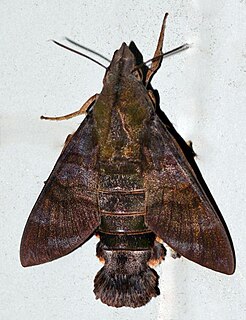
Macroglossum corythus is a species of hawk moth of the family Sphingidae. It was described by Francis Walker in 1856 and is found throughout the Indo-Australian tropics east to New Caledonia.

Thyas coronata is a species of moth of the family Erebidae first described by Johan Christian Fabricius in 1775. It is found from the Indo-Australian tropics of southern China, Taiwan, Japan, Nepal, India, Sri Lanka to Micronesia and the Society Islands.

Eudocima phalonia, the common fruit-piercing moth, is a fruit piercing moth of the family Erebidae. The species was first described by Carl Linnaeus in his 1763 Centuria Insectorum. It is found in large parts of the tropics, mainly in Asia, Africa and Australia but introduced into other areas such as Hawaii, New Zealand and the Society Islands. It is one of major fruit pests in the world.
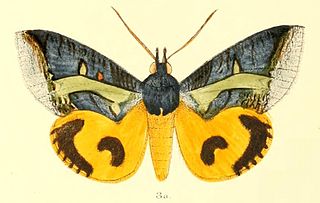
Eudocima homaena is a moth of the family Erebidae first described by Jacob Hübner in 1816. It is found in the Indian subregion, Sri Lanka, Taiwan, the Nicobars, Peninsular Malaysia, Borneo, the Philippines and on Christmas Island. It is a major pest on orange plants.
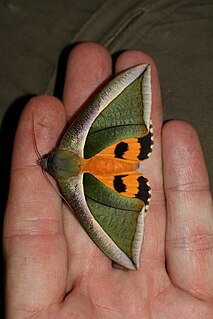
Eudocima salaminia, the green fruit-piercing moth, is a moth of the family Erebidae. The species was first described by Pieter Cramer in 1777. It is found from India, and across south-east Asia to the Pacific Islands. In Australia it occurs in the Northern Territory, Queensland and New South Wales. The adult is a fruit piercer.

Pergesa is a monotypic moth genus in the family Sphingidae first described by Francis Walker in 1856. Its only species, Pergesa acteus, the green pergesa hawkmoth, was described by Pieter Cramer in 1779.

Stauropus alternus, the lobster caterpillar, lobster moth or crab caterpillar, is a moth of the family Notodontidae. It is found in the north-eastern Himalaya, Sri Lanka, Sundaland, the Philippines, Sulawesi and the southern Moluccas. It was described by Francis Walker in 1855.

Asota plana is a moth in the family Erebidae first described by Francis Walker in 1854. It is found from the Oriental tropics east to New Guinea.

Trabala vishnou, the rose-myrtle lappet moth, is a moth of the family Lasiocampidae. It is found in south-east Asia, including Pakistan, India, Thailand, Sri Lanka, Myanmar, Java, China, Japan, Taiwan, Hong Kong, Vietnam and Indonesia. Four subspecies are recognized.
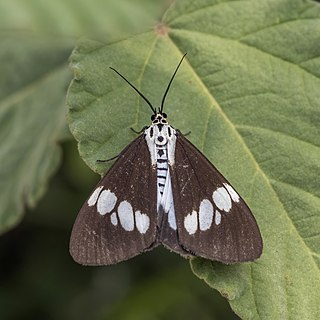
Nyctemera lacticinia, the common nyctemera, is a moth of the family Erebidae. The species was first described by Augustus Radcliffe Grote in 1873. It is found in Japan, from the Oriental tropics of India, Sri Lanka, Myanmar to Taiwan, Peninsular Malaysia and Borneo.

Tiracola plagiata, the cacao armyworm, is a moth of the family Noctuidae. The species was first described by Francis Walker in 1857. It is found from south-east Asia, South India, Sri Lanka, Myanmar to the South Pacific Islands, including the northern two-thirds of Australia.
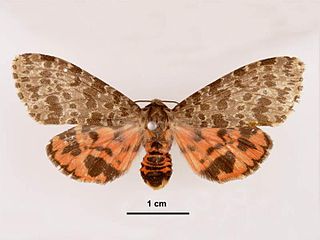
Olepa ricini is a moth of the family Erebidae first described by Johan Christian Fabricius in 1775. It is found in Bangladesh, India, Nepal, and Sri Lanka. An older treatment placed the species in the genus Pericallia.

Orgyia postica, the cocoa tussock moth or hevea tussock moth, is a species of moth of the subfamily Lymantriinae of family Erebidae found from the Oriental tropics of India, Sri Lanka, Myanmar, Borneo, Java, New Guinea and Taiwan. It was described by Francis Walker in 1855.

Arctornis submarginata is a species of moth of the subfamily Lymantriinae of family Erebidae. It is found in the north-eastern Himalaya and Sikkim, Sri Lanka, on Borneo and Sumatra and in northern Australia.

Aloa lactinea, the red costate tiger moth, is a moth of family Erebidae. The species was first described by Pieter Cramer in 1777. It is found in India, Japan, southern and western China, Taiwan, Java, Sumatra, Sri Lanka, Myanmar and the Philippines.

Autoba abrupta is a species of moth of the family Erebidae. It is found in Papua New Guinea, Thailand, and Australia. The species is largely used by the name Eublemma abrupta in Indian and Sri Lankan texts.
Drapetodes fratercula is a moth in the family Drepanidae. It was described by Frederic Moore in 1887. It is found in Sri Lanka, north-eastern Himalaya, Borneo, Bali, and Sulawesi.


















